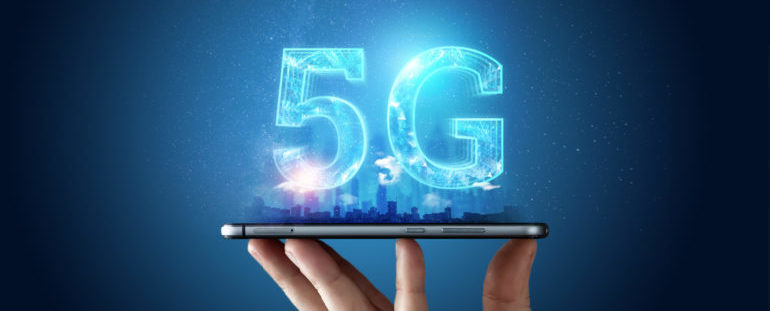
By Bill Kammer
As we start a new decade, this article looks ahead to the changes and challenges of the New Year.
5G IS HERE — OR IS IT?
This is probably not the time to drink the 5G Kool-Aid. The fifth generation of mobile device technology has arrived, but the product offerings are probably an unnecessary immediate investment. When complete, 5G will be the path of evolution from every carrier’s current 4G LTE technology. 5G basically involves two components. One component, available from some carriers, offers only a connection that greatly resembles the speed and characteristics of 4G LTE. The other component, the one that will offer high speeds and downloads, is probably at least a year away.
The high-speed applications promised require high frequencies called mmWave. The basic rule of communications is that the higher the frequency, the shorter the distance that signals can travel. Most present mobile phone frequencies are below 2 gigahertz (GHz). mmWave frequencies that carriers will use will be above 24 GHz. They will only travel a short distance and cannot easily penetrate buildings. Additionally, only the latest mobile devices are 5G capable, and some of the ones on the market cannot use the mmWave frequencies. Those 5G frequencies require infrastructure build-out that is in progress, but hardly completed.
These manufacturing and infrastructure challenges have not prevented carriers from marketing 5G to customers. Some advertisements refer to mmWave rollouts that exist only in certain NFL stadiums or in a few cells in urban centers. Other ads refer to comprehensive national coverage, but only in the lower frequencies that provide the service that only resembles 4G LTE.
Best advice is to wait and see what your carrier is offering; whether it is available in the areas where you live or work; and what mobile device models can use this new technology. This 5G rollout highly resembles the problems we experienced in the earliest days of cellular communication when a phone might work on only one carrier’s network and you had to determine if that carrier’s service was spotty or unavailable in the area near your home or office.
EPHEMERAL MESSAGING
I last wrote about texts being the new email. As 2020 develops, particularly in eDiscovery, ephemeral messaging will be another and further development. Ephemeral basically refers to applications that facilitate communications or collaboration, but which may not be preserved for a substantial period. Familiar names include Snapchat, WhatsApp, Telegram, Wickr and Signal. Their principal characteristic is a feature that will delete a message after a set period of time. Other messaging applications that facilitate collaboration in the workplace, such as Slack, may leave behind data or ESI that can be collected or analyzed. Much commentary discusses whether businesses are well-advised to allow the use of messaging apps or collaborative hangouts and whether or not they have a regulatory or ethical obligation to preserve the contents of those messages and conversations. Electronic discovery will focus on these applications and potentially implicate the evidentiary impact of the practices of an entity that does not require preservation of the content of those conversations.
THE ETHICS OF TECHNOLOGY COMPETENCE
Almost 40 states require technology competence for all attorneys. The ABA, the State Bar and the SDCBA have all issued opinions to that effect. Those opinions admonish attorneys to choose between learning the technology, working with someone who possesses it or declining a particular representation. Maintaining required competence is an evolving obligation that only gets more difficult with passing time. The areas affecting that competence include not only discovery but also cybersecurity, communications and encryption. We cannot pause in our efforts to maintain and enhance our competence without forsaking those ethical obligations.
LEGAL ANALYTICS
Many software developers continue to produce and evolve products that allow attorney analysis of masses of data. Products are available for legal research, judicial research, electronic discovery and similar endeavors. “Buyer Beware” continues to be cogent advice. Except for the efforts of law librarians, there is little consumer research or comparative rankings to assist attorneys in determining whether a particular product will enhance their ability to serve their clients, analyze contracts, or simplify the expense and effort of discovery. We must remain aware of developments in these areas that would justify a conclusion that the return on our investment, in time and expense, is worthwhile.
SMART HOMES AND OFFICES
You can’t miss the ads for Alexa, Nest, Ring, Philips Hue and smart TVs. All depend on the internet of things (IoT), the linking of devices on a network that may not be secure. Late last year, the FBI issued a warning that your smart TV might be spying on you, noting that the interconnection of unsecured devices might allow hackers to penetrate your home or office network, wreak havoc, corrupt functions or cyberstalk you. Basically, they issued a general reminder that the convenience of these devices may come at a cost that renders them a poor bargain.
The only common thread to these thought categories is that 2020, and the years following, will involve a steady evolution of processes and devices we use daily at home or work. That evolution will affect our practices and experiences and require constant attention and learning. Climb aboard for the ride!
Bill Kammer is a Partner with Solomon Ward Seidenwurm & Smith, LLP.